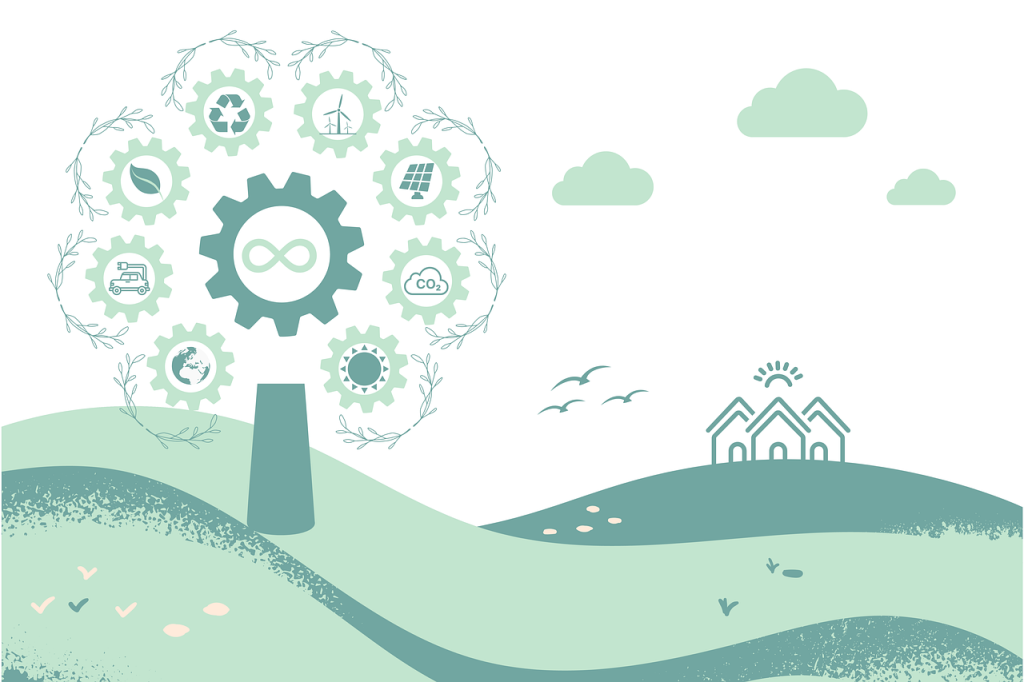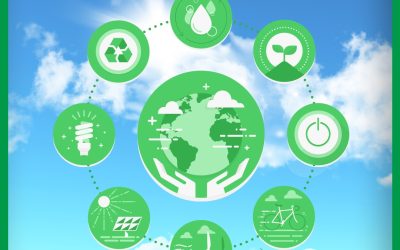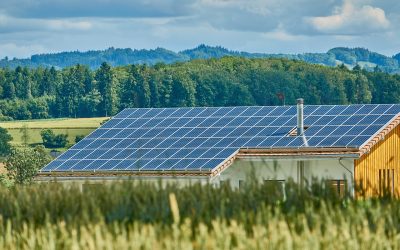Imagine a world where renewable energy sources are the norm, where sustainability is at the forefront of every industry. In this world, governments and businesses prioritize the green economy, leading to the creation of jobs, the reduction of carbon emissions, and a healthier planet for future generations. It’s not just a dream; it’s a reality. The movement towards a stronger green economy is gaining momentum, and its impacts are far-reaching. From the adoption of renewable energy technologies to the promotion of sustainable practices, the strengthening of the green economy holds the key to a more sustainable and prosperous future.

1. Introduction to Green Economy
1.1 Definition and Concept of Green Economy
A green economy refers to an economic system that aims to promote sustainable development by minimizing environmental impacts and enhancing resource efficiency. It involves the adoption of environmentally friendly practices and technologies in various sectors, including energy, agriculture, transportation, and infrastructure. The concept of a green economy emphasizes the need to transition from a traditional, resource-intensive model to a more sustainable and inclusive economy.
1.2 Importance of Green Economy
The importance of a green economy cannot be overstated. It offers a path towards a more sustainable future, where economic growth and environmental protection can go hand in hand. By integrating sustainable practices into various sectors, a green economy can help mitigate the adverse impacts of climate change, reduce pollution, promote biodiversity conservation, and ensure the efficient use of resources. Additionally, it can create new job opportunities, stimulate innovation, and enhance overall socio-economic well-being.
1.3 Goals and Objectives of Green Economy
The primary goals of a green economy include achieving sustainable development, reducing carbon emissions, fostering resource efficiency, and promoting social equity. By focusing on these objectives, a green economy seeks to address the pressing challenges of climate change, environmental degradation, and social inequality. It aims to shift towards cleaner and more sustainable production and consumption patterns, while also ensuring that the benefits of such a transition are shared equitably among all sections of society.
2. Policy Framework for Green Economy
2.1 Government Initiatives and Regulations
Government initiatives and regulations play a crucial role in shaping the transition towards a green economy. Governments can establish policies and regulations that incentivize the adoption of sustainable practices and technologies. This can include providing financial support for green projects, introducing carbon pricing mechanisms, implementing stricter environmental standards, and promoting renewable energy targets. Furthermore, governments can create a conducive policy environment that encourages private sector investments in green industries and fosters innovation.
2.2 International Agreements and Commitments
International agreements and commitments also contribute to the policy framework for a green economy. Countries come together to establish global targets, such as the Sustainable Development Goals (SDGs) and the Paris Agreement on climate change. These agreements provide a framework for cooperation and coordination among nations to address common environmental challenges. By adhering to these commitments, countries can align their policies and actions with international best practices, facilitating the transition towards a more sustainable and green economy.
2.3 Supportive Policies for Green Industries
Supportive policies for green industries are essential for their growth and development. Governments can provide financial incentives, tax breaks, and grants to encourage investments in renewable energy, sustainable agriculture, and other green sectors. They can also support research and development efforts to spur innovation in clean technologies. Additionally, policies that promote green procurement, sustainable public transportation, and eco-friendly infrastructure contribute to the overall development of a green economy.
3. Renewable Energy Sector
3.1 Growth and Investment in Renewable Energy
The renewable energy sector has witnessed significant growth and investment in recent years. Renewable energy sources, such as solar, wind, hydro, and geothermal power, have become increasingly affordable and accessible. Governments and private investors have recognized the potential of renewable energy as a clean and reliable source of power. As a result, there has been a surge in investment in renewable energy projects, leading to the expansion of infrastructure and the development of new technologies in this sector.
3.2 Advantages of Renewable Energy Sources
The advantages of renewable energy sources are numerous. Unlike fossil fuels, renewable energy sources are abundant and do not deplete over time. They also do not emit greenhouse gases during power generation, making them crucial in efforts to combat climate change. Additionally, renewables offer opportunities for decentralized energy production, reducing dependence on centralized power grids. Furthermore, the use of renewable energy can improve energy security, stimulate economic growth, and create employment opportunities in local communities.
3.3 Integration of Renewable Energy into Grid Systems
The integration of renewable energy into grid systems is a critical aspect of transitioning to a green economy. As the share of renewable energy in the overall energy mix increases, it is essential to ensure that the power generated can be efficiently transmitted and distributed. Smart grid technologies, energy storage solutions, and advanced grid management systems play a crucial role in enabling the smooth integration of renewable energy sources. By optimizing grid systems and enhancing their flexibility, renewable energy can become a reliable and cost-effective solution for meeting global energy demands.
4. Sustainable Agriculture and Food Systems
4.1 Organic Farming and Agroecology Practices
Promoting organic farming and agroecology practices is a key component of building a sustainable agriculture and food system. Organic farming emphasizes the use of natural inputs, such as organic fertilizers and biological pest control methods, instead of synthetic chemicals. Agroecology, on the other hand, focuses on creating ecological balance and resilience in agricultural systems through biodiversity conservation, crop rotation, and soil health management. By adopting these practices, farmers can reduce the reliance on chemical inputs, protect soil fertility, conserve water resources, and enhance biodiversity.
4.2 Increasing Efficiency in Food Production
Increasing efficiency in food production is essential for ensuring food security and reducing environmental impacts. Sustainable farming practices, such as precision agriculture and drip irrigation, help optimize resource use and minimize waste. Improved storage and transportation infrastructure can also reduce post-harvest losses and ensure food reaches consumers in a timely manner. Furthermore, promoting sustainable livestock rearing practices, such as managed grazing and feed optimization, can enhance overall efficiency and minimize the environmental footprint of the agriculture sector.
4.3 Climate Resilient Crop Varieties
Developing climate-resilient crop varieties is crucial in the face of climate change and its impacts on agricultural productivity. By breeding and cultivating crops that are more resistant to drought, pests, and diseases, farmers can mitigate the risks associated with changing climatic conditions. Additionally, promoting the use of traditional and indigenous crop varieties that are adapted to local environments can enhance biodiversity and foster sustainable agriculture. Investment in agricultural research and development is essential to drive innovation and develop crop varieties that can thrive in a changing climate.

5. Circular Economy and Resource Efficiency
5.1 Transitioning from Linear to Circular Economy
Transitioning from a linear to a circular economy is imperative to minimize resource depletion and waste generation. In a circular economy, resources are used, recycled, and reused in a closed-loop system, reducing the need for extracting new resources and minimizing waste. This can be achieved through various strategies, including product design for recyclability, extended producer responsibility, and the promotion of sharing and circular business models. Embracing a circular economy approach enables the efficient use of resources, reduces environmental impacts, and fosters sustainable consumption and production patterns.
5.2 Strategies for Improving Resource Efficiency
Improving resource efficiency is crucial in reducing the environmental footprint and enhancing the sustainability of economic activities. This involves optimizing resource use in various sectors, such as energy, manufacturing, and construction. Strategies for improving resource efficiency include energy-efficient technologies, waste reduction measures, water-saving practices, and material recycling. By adopting these strategies, businesses and industries can minimize their resource consumption while maximizing production outputs, leading to cost savings and reduced environmental impacts.
5.3 Recycling and Waste Management
Recycling and waste management are essential components of a green economy. Proper waste management practices, including waste segregation, collection, and recycling, can significantly reduce the amount of waste sent to landfills and incinerators. Recycling not only conserves resources but also reduces energy consumption and greenhouse gas emissions associated with the production of virgin materials. Governments, businesses, and individuals all have a role to play in promoting recycling and waste management practices to foster a more sustainable and circular economy.
6. Green Infrastructure and Urban Planning
6.1 Designing Sustainable Cities
Designing sustainable cities is crucial for creating livable and environmentally friendly urban spaces. Sustainable urban planning involves considerations such as efficient land use, mixed land-use zoning, green spaces, and sustainable transportation systems. By incorporating these elements, cities can minimize sprawl, reduce pollution, and enhance the quality of life for residents. Sustainable cities also prioritize the provision of clean and affordable energy, efficient water and waste management systems, and climate-resilient infrastructure.
6.2 Green Building and Infrastructure
Green building and infrastructure play a significant role in advancing the green economy. Green buildings utilize sustainable construction materials, energy-efficient technologies, and incorporate design elements that optimize natural lighting and ventilation. Additionally, green buildings can generate renewable energy on-site, minimize water consumption, and effectively manage waste. As for green infrastructure, it involves the development of sustainable transportation networks, smart grid systems, and nature-based solutions, such as green roofs and urban forests. Green buildings and infrastructure contribute to energy savings, reduce greenhouse gas emissions, and enhance the overall sustainability of urban areas.
6.3 Urban Mobility and Transportation
Promoting sustainable urban mobility and transportation is essential for reducing congestion, improving air quality, and minimizing carbon emissions. Encouraging the use of public transportation, cycling, and walking can reduce the reliance on private vehicles and alleviate traffic congestion. The adoption of electric and hybrid vehicles, along with the development of charging infrastructure, can help transition towards cleaner transport options. Moreover, integrating intelligent transportation systems, promoting carpooling, and investing in efficient logistics and freight management contribute to sustainable urban mobility and transportation, thereby strengthening the green economy.

7. Innovation and Technology in Green Economy
7.1 The Role of Technology in Green Transition
Technology plays a pivotal role in driving the green transition by enabling the development and deployment of clean and sustainable solutions. Advancements in renewable energy technologies, energy storage systems, and smart grid technologies have revolutionized the energy sector. Similarly, innovations in agriculture technologies, such as precision farming and vertical farming, have improved resource efficiency and productivity. Furthermore, digital solutions, data analytics, and artificial intelligence are empowering environmental monitoring and management efforts. Leveraging technology in the green economy fosters innovation, enhances efficiency, and accelerates the adoption of sustainable practices.
7.2 Innovations in Clean Energy and Sustainability
Clean energy and sustainability have witnessed remarkable innovations in recent years. New technologies, such as solar photovoltaics, wind turbines, and energy storage systems, have become more efficient and cost-effective, making them viable alternatives to fossil fuels. Innovations in sustainable materials, such as bioplastics and eco-friendly construction materials, are contributing to a more sustainable manufacturing industry. Additionally, advancements in water and waste management technologies are improving resource efficiency and reducing pollution. The continuous pursuit of innovation in clean energy and sustainability is instrumental in achieving the goals of a green economy.
7.3 Digital Solutions for Environmental Monitoring
Digital solutions are increasingly being used for environmental monitoring and management. Remote sensing technologies, satellite imagery, and geographic information systems (GIS) enable the collection and analysis of data on various environmental parameters, such as air quality, water quality, and land use. This data-driven approach facilitates informed decision-making and helps identify areas for improvement in environmental management practices. Digital solutions also enable the development of citizen science initiatives, where individuals can actively participate in data collection and monitoring efforts, fostering a sense of environmental stewardship and engagement.
8. Job Creation and Economic Growth
8.1 Green Jobs and Employment Opportunities
The green economy creates numerous job opportunities across various sectors. The transition to renewable energy sources, sustainable agriculture practices, and the implementation of green infrastructure projects require skilled and specialized manpower. Jobs in renewable energy installation, energy auditing, eco-tourism, waste management, and sustainable construction are just a few examples of the diverse employment opportunities in the green economy. Moreover, green jobs are often associated with better working conditions, higher wages, and greater job satisfaction, contributing to overall socio-economic well-being.
8.2 Economic Benefits of Green Economy
The green economy offers several economic benefits that contribute to sustainable development. Investment in green industries and infrastructure stimulates economic growth, as it creates demand for goods and services in these sectors. Additionally, the shift towards renewable energy reduces dependency on fossil fuel imports, enhancing energy security and reducing trade imbalances. The adoption of resource-efficient practices and technologies also leads to cost savings for businesses, improving their competitiveness. Furthermore, the green economy fosters innovation and entrepreneurship, driving technological advancements and enhancing global competitiveness.
8.3 Inclusive and Equitable Development
One of the core principles of a green economy is inclusive and equitable development. By promoting sustainable practices and green jobs, the green economy seeks to ensure that the benefits of economic growth are shared among all members of society. This involves providing equal opportunities for employment, education, and participation in decision-making processes. Moreover, a green economy emphasizes social protection, poverty reduction, and the empowerment of marginalized communities. By prioritizing inclusivity and equity, the green economy can contribute to the achievement of the United Nations’ Sustainable Development Goals and promote a more just and sustainable world.
9. Financing Green Economy
9.1 Public and Private Funding for Green Projects
Financing green projects requires a mix of public and private funding. Governments play a vital role in providing financial support through grants, subsidies, and incentives for green initiatives. Public banks and development finance institutions can also provide low-interest loans or guarantees to stimulate investments in the green economy. On the other hand, private sector investments, including venture capital, impact investments, and green bonds, are crucial for scaling up green businesses and technologies. Public-private partnerships can further leverage resources and expertise to mobilize the necessary funding for the green economy transition.
9.2 Green Bonds and Impact Investments
Green bonds and impact investments have gained prominence as innovative financing mechanisms for the green economy. Green bonds are financial instruments used to raise capital for projects with environmental benefits, such as renewable energy projects or energy-efficient buildings. These bonds provide investors with an opportunity to support sustainable initiatives while earning a financial return. Impact investments, on the other hand, focus on generating measurable social and environmental benefits alongside financial returns. Both green bonds and impact investments channel funds towards green projects and help bridge the financing gap for the transition to a sustainable and green economy.
9.3 Financial Incentives and Subsidies
Financial incentives and subsidies play a crucial role in promoting investments in the green economy. Governments can offer tax credits, feed-in tariffs, or grants to businesses and individuals that adopt sustainable practices or invest in renewable energy projects. Similar incentives can be provided for the purchase of energy-efficient appliances or electric vehicles. These financial incentives reduce the financial barriers associated with adopting sustainable technologies and practices, making them more accessible and attractive. By leveraging financial incentives and subsidies, governments can accelerate the transition to a green economy and generate long-term economic, environmental, and social benefits.
10. Challenges and Future Outlook
10.1 Overcoming Barriers to Green Transition
The transition to a green economy faces various barriers that need to be addressed. One significant challenge is the high upfront costs associated with green technologies and practices. The initial investment required for renewable energy projects or sustainable agriculture practices can deter potential adopters. However, continued innovation and supportive policies can drive down costs and make green solutions more affordable and accessible. Additionally, regulatory obstacles, limited awareness and knowledge, and resistance to change pose challenges to the green transition. Overcoming these barriers requires a collaborative effort involving governments, businesses, communities, and individuals.
10.2 Addressing Social and Environmental Equity
Ensuring social and environmental equity is a critical aspect of the green economy. It is essential to ensure that the transition to a green economy does not exacerbate existing social inequalities or lead to the marginalization of certain groups. Efforts should be made to involve marginalized communities in decision-making processes and provide them with equal access to green jobs and opportunities. It is also crucial to address the potential environmental impacts of green projects, such as land-use conflicts or the displacement of indigenous communities. By adopting an inclusive and equitable approach, the green economy can foster social cohesion and environmental justice.
10.3 Embracing Innovation for Sustainable Development
Embracing innovation is essential for the future of the green economy. Continuous advancements in technology, research, and development are necessary to overcome existing challenges and tap into new opportunities. Governments, businesses, and research institutions should prioritize investment in green innovation, fostering collaboration and knowledge-sharing. This includes supporting research on clean technologies, promoting entrepreneurship in the green sector, and facilitating the transfer of technology to developing countries. By embracing innovation, the green economy can unlock its full potential and contribute to sustainable development on a global scale.
In conclusion, the green economy represents a transformative approach to economic development that prioritizes sustainability, resource efficiency, and social equity. By integrating green practices across various sectors and adopting supportive policies, governments, businesses, and individuals can contribute to a more sustainable and inclusive future. The transition to a green economy requires concerted efforts, innovative solutions, and financial support. Overcoming barriers and addressing challenges will pave the way for a future where economic growth goes hand in hand with environmental protection and social well-being.










